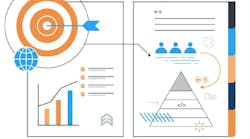Throw Out Your Org Chart: Five Steps to Redesigning Your Organization
When you make a move from a small apartment into your very first house, you’re likely to notice right away that you’ll need to make some changes. Suddenly you find yourself with more rooms than furniture, or apartment décor that doesn’t fit with the style of your new home.
The same thing happens when you create a new strategy for your organization as it grows and evolves. You immediately discover gaps—gaps that exist because you now have new objectives and a need for new skills to achieve them.
When you move into a new space, you have to figure out how you will fill it to make it functional. Would your small two-top kitchen table look right in your sprawling new dining room? The same is true with the functions your staff may have been performing before the new strategy was defined. Can you just allocate existing staff to perform the new functions? Probably not.
Traditionally, when organizations adopt a new strategy and require people to perform new functions to make it work, the immediate reaction is to go straight to creating an org chart. Instead of identifying the processes, culture, and talent that need to work in concert with the organizational structure, traditional methods usually involve reassigning Jane from client services to the newly defined strategic partnership team, or simply creating a new job title and putting Jane’s name under it.
To begin to redesign an organization, focus on answering questions such as, “What are the functions this organization needs to be successful in its future state?” and “What are the new skills that are required for this to happen?” Changes need to be analyzed and planned as part of a system. For any organization to accomplish this successfully, it will need to focus on five core steps.
1) Ensure all your stakeholders understand your new strategy
When you have developed a new strategy, ask your stakeholders about the strategy’s core elements and the rationale behind them. Can they articulate them? Do they know how the new strategy will affect their work, or that of their team? Before you can realize your strategic objectives, you need to know how people feel about it and whether they all buy into the same long-term goals.
2) Define the functions necessary for success
Branding and communications, project management, product and service innovation, talent management—these are some examples of core functions that could be necessary to meet your new strategic goals. Some core functions will be new to the organization; others will not.
Whatever the functions, it’s critical that you visualize the dependencies among them, not their hierarchical relationships. This new vantage point will break presumptive ideas about value and impact within the organization. When you make the visual of your organization both hierarchy- and people-neutral, you are freed up to focus on what the organization does, rather than who is doing it.
3) Identify the capabilities required to achieve your new strategy
The best way to figure out what skills will be vital to your organization’s future success is to hold interviews and focus groups with your staff. This allows their voices to be heard and helps you amass an understanding of what skills are most critical to the future success of your organization. With this broad list of skills, your leadership team can begin to connect the skills to the activities you identified in the previous step.
4) Assess your talent
Your organization now has a non-hierarchical blueprint of the core activities it must perform going forward. Similar to your house plans, you will need to figure out what (or who) fits where. It is time to address these critical talent questions:
- What are the talent capabilities of your staff, and do you have a method of evaluating those capabilities that is both fair and transparent?
- What are your skill gaps in the new organizational design?
- Will you focus on building capacity by training up or by building cross-functional teams?
- Will you hire new staff members to perform new functions?
5) Shape your processes and culture
As your organization changes, you’ll need to identify the cultural shifts needed to make the strategic shifts work. For example, greater accountability may become more critical, so you may need to invest in stronger performance management processes and reviews, ensuring that these are aligned to the new functions and with clear ownership.
So what does this all amount to? Strategic success only occurs when an organization is designed specifically to achieve its new objectives. Only a holistic view of your organization—one that strips away the hierarchy, boxes and arrows, people and places, and focuses entirely on defining the specific activities the organization must perform to achieve its goals—can prepare an organization for long-term success.
Teri Riddle is CEO and Kelly Pradhan is Managing Director for The Crossland Group, a management consulting firm that helps public- and private-sector clients design effective organizations that support their strategies. Teri holds an MBA in international business from Boston University School of Management and Kelly has a PhD in Industrial and Organizational Psychology from the University of Georgia.




